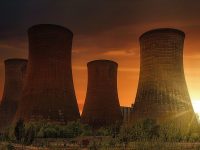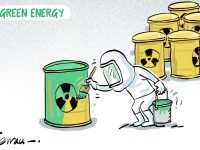 Red Eléctrica de España Red Eléctrica de EspañaPower lines mark the landscape and thus rouse public objection. |
||
|
Electricity plays a leading role in the 21st century. The ability to generate electricity using renewable and CO2-free technology provides the key to a sustainable future. However, there are still hurdles to overcome, such as the isolation of Spain from the rest of Europe in terms of energy or the ability of technology to meet weather-dependent energy flow. |
||
|
The use of different energy sources has marked the history of mankind and each society’s position in the world. Harnessing wind power enabled the Phoenicians to dominate in the Mediterranean, while exploiting the strength of water enabled us to grind our flour in Europe for a long time, and steam power made the industrial revolution possible. Nowadays, it is common knowledge that electricity plays a leading role in 21st century society and will be increasingly relevant, even more so than in the last century. One cannot conceive of a sustainable energy model, i.e., a model of sustainable society, without including energy, an essential component of our technological world. Indeed, no one can doubt that this current central role will be heightened in the future to the extent that the electric vector will become the real axis of the shift towards sustainable energy use. An electricity-dependent society Both the generation of and demand for electricity present advantages. Regarding generation, thanks to electricity, we can use large-scale renewable energy sources such as the power available to us from the wind, water and sun. Also thanks to this energy carrier, we can also enjoy other CO2-free technologies such as nuclear energy, and others that contribute to system efficiency like cogeneration. We will also go on using fossil fuels, while still available, with CO2 capture and storage, and in all likelihood, the future will see the use of nuclear fusion. Regarding demand, electricity has the enormous advantage that the emissions are zero at the point of consumption, regardless of how it was generated, which is of considerable importance in cities where air quality is an increasingly pressing problem. It is also important for energy efficiency technologies, such as LEDs or heat pumps. Finally, electricity is the energy input required by today’s society based on information, services, technology and knowledge, the four pillars characterising modern life. It is exceptionally ingrained in our habits and needs, so much so that today’s citizens are increasingly electricity-dependent. |
||
|
|
«Electricity plays a leading role in 21st century society and will be increasingly relevant, even more so than in the last century» |
|
|
Road transport is probably the last great energy-related field left to be conquered. Until now it would seem to belong exclusively to the petroleum domain, but batteries and electric vehicles can provide significant opportunities for electricity in this area too. It may not happen in this decade, but it is clear that, due to both the cost of extraction and environmental impact, oil will gradually be replaced by electricity, which provides a major benefit in terms of air quality and noise reduction in cities. It is safe, therefore, to say that the future of electricity is a decisive factor in our energy future or, rather, that our energy future will be moulded by the future shape of electricity. Therefore, it is essential to develop it to its full potential, allowing us to move towards a safer and more sustainable model, which simultaneously supports the competitiveness of our economy and provides environmental protection in its broadest sense. This challenge is new and imperative because the demands placed on electric supply have changed greatly in recent years. Now we must be able to regulate less amenable systems, not like in the past when to ensure the instant equilibrium between supply and demand it was enough to give instructions to coal power plants or hydroelectric dams to increase or decrease production. That is, in the past demand was the controlling factor and production was instantly adjusted accordingly. Now, however, a large part of our power production mix is unmanageable, that is, energy is produced when there is wind, water or sun, and not when demand requires it. Thus, we are forced to find ways to compensate for this variability and the solution is neither simple nor obvious, but the sum of many factors. he complex integration of renewables into the electric power system In Spain we are in a good position to face the fluctuations of renewable energy because we have already covered an important stretch of road. Our country has witnessed two circumstances that have not occurred simultaneously elsewhere, and that have forced us to go further in this respect than other countries. On the one hand, we have a very high number of wind power installations, which now represents 21,000 megawatts (MW) while, on the other, Spain has a very limited ability to interconnect with the European electric power system. To demonstrate this weakness, it is sufficient to compare Denmark’s electric interconnection potential with its neighbours, Germany, Sweden and Norway, representing 60% of maximum peak demand, while in Spain the interconnection of our system stands at just 3%. Thus, these conditions together have forced us to take a step forward and stay ahead in terms of the integration of wind energy. Our country’s sustained commitment to renewable energy has been made possible thanks to the design and development of a pioneering model for the integration of these energies, especially wind power, into the electric power system. Red Eléctrica de España (REE), a company responsible for operating and distributing the electric power system, has taken on the responsibility of providing solutions that can make the goals of energy policy viable. Thus, it launched CECRE in 2006, a centre for renewable energy control (Centro de Control de Energías Renovables), which has managed to establish a coordinated relationship between energy generation, transmission and system operations. |
||
|
|
«A large part of our power production mix is unmanageable, that is, energy is produced when there is wind, water or sun, and not when demand requires it» |
|
|
The work carried out by this centre has put Spain in a leading position worldwide and has solved the challenge, making this high contribution of renewable energy possible, both safely and efficiently, in an almost insular system. The key to being able to get so far in this integration has been the ability to foresee problems and provide technical systems that enable renewable energy to be managed in a way that is increasingly similar to conventional energy management. Today, thanks to CECRE, we can respond to the fluctuations in renewable energy generation and can fully guarantee the safety of supply. We can reliably deal with situations in which 60% of demand is met by wind power, as happened on November 6, 2011, and others where wind energy covers just 1%. Fluctuation, expressed in MW, means going from 15,000 to 150, and with an interconnection capacity with the rest of the European electric power system, the safety network, of 1,400 MW. Besides, one must also bear in mind that wind power generation moves across the country, in line with the wind passing across the national territory which is generally from west to east. This shifting energy production could be likened to ten conventional gas-powered stations generating in north-western Spain in the morning, in the Ebro valley eight hours later, and on the Mediterranean coast eight hours after that, but without ceasing to generate at any time. The ability not to waste that energy and make it safely available to the electric power system is one great achievement of our control centre, making it a must-see for those who wish to integrate wind energy safely anywhere in the world. It is true to say we have worked hard to achieve this and Spanish leadership is recognised by governments, institutions and professionals working in the industry in even the most advanced countries, which often visit the CECRE. Notwithstanding, the challenges do not end here as we still have a long way to go if we are to achieve European targets, requiring 20% of primary energy to come from renewable sources and represent 40% in the electricity sector by 2020. |
||
|
|
«The inevitable growth of the electrical grid has a cost, a social and landscape-related cost rather than an economic one, as power lines stir up important and ever-growing public opposition» |
|
|
Overcoming the challenge of energy isolation Spain’s main difficulty lies in the country’s special circumstances regarding electricity. As mentioned above, our interconnection with Europe in this respect is very small, which makes our operation almost island-like, from the electrical point of view. It is precisely because we are not in the centre of Europe that we cannot fall back on the European electric power system, ten times greater than the Spanish one, to mitigate the problems posed by high fluctuation of weather-dependent energy supply, which can change daily or from one minute to the next. So, a priority is to intensify our interconnection with Europe. This is already underway with the construction of a new power line through the eastern Pyrenees, which will double our current capacity. This line will become operative by around 2014, and is a huge improvement that will allow us to increase from the current 3% of interconnection capacity to 6%, in terms of peak demand, but will still be very far from the 10% the EU identifies as the ideal minimum interconnection capacity between each country and its neighbours. We must, therefore, further enhance our connection with Europe and in another project the feasibility and possible routes for another line are already being discussed with our French colleagues, which will probably run along the Bay of Biscay. And we should envisage yet another possible interconnection before the end of this decade. In parallel, we should work on other solutions, which combined can help to improve the efficiency of an electric power system in just a few years, a system that bears no resemblance to what we had just a short time ago. This energy generation model behaves, as I said before, capriciously, depending on the wind or sun, but it is still necessary to ensure the instant equilibrium between supply and demand. To do so, apart from greater interconnection, we need more storage capacity. At present, storage is only possible on a suitable scale by reversible water pumping stations, whose power must be increased. In this scenario the need for additional power supply is inevitable because renewable power production facilities are scattered throughout the country. Managing power distribution from source to destination requires a more robust grid than conventional power production demands. And it is a fact that this grid has a cost, not so much in economic terms since the distribution network accounts for just 5% of the cost of the electric power system as a whole, but rather a social cost related to landscape preservation as power lines stir up important and ever-growing public opposition. We face a great challenge –but a great opportunity too– and must persuade society of the need for a more sustainable electric power system, with a greater contribution of renewable energy sources and this, I insist, calls for a system with a more robust transmission grid and network. |
||
 Red Eléctrica de España Red Eléctrica de EspañaThe risk of birds colliding with power lines can be avoided by placing special devices on the lines. |
||
|
Facing the future with smart technology Moreover, the development of information technologies will enable us to manage demands more and more intelligently. Consumer behaviour can be modified by the implementation of smart meters and instant interactivity between the meter and the distribution network, and subsequently system operation and transport. Indeed, consumers may become key agents of change if their consumption shifts from peak to off-peak hours and if some consumers are able to react to the availability and cost of supply. In this respect, electric cars can also be an important ally of a more sustainable system if recharged intelligently, that is, if the process is optimised so that most vehicles are recharged in off-peak night-time hours, when there may be an excess of renewable energy. In short, nowadays electricity is at the core of change towards a sustainable energy sector. Maybe the future will see other key players arise, other vectors, but the main player today is electricity, without doubt. Electricity is also very flexible in that it is highly versatile and can combine technologies and primary energy, although the cleanest should always be chosen. There is still much work ahead, and the Spanish electricity sector must adapt to changes that will make the adoption of a new model possible. This will require the maximum involvement of all stakeholders, from administrators to consumers, through all the players in the system. I am convinced that together we will be able to achieve this fundamental commodity, key in economic development and necessary to maintain the quality of life, making it available to society in a safe and reliable way, and at a reasonable price, a commodity that is essential for economic competitiveness and environmental conservation as a whole. And I think we will be able to do so because, as Albert Einstein said: «There is a driving force more powerful than steam, electricity and nuclear power: the will». Luis Atienza. Former President of Red Eléctrica de España (Spanish Electricity System), Madrid |
||
Search
© Mètode 2012 - 73. Online only. The Strength of the World - Spring 2012

 Daily trends in power production and demand. The maximum power demand on the electric power system occurred at 8 pm on December 17, 2007, and amounted to 45,450 megawatts (MW). The curves, prepared daily by the system operator Red Eléctrica de España (Spanish Electricity System), show the forecast for each hour of the day (red line), daily forecasts (green line) and trends in real demand (yellow line). The task of the transmission grid manager is to provide good electric forecasts daily and inform producers, thus ensuring that power generation corresponds to demand exactly and to the millisecond, to keep a constant 50 Hz frequency. This means processing about 270,000 data related to production and demand every four seconds. Should the frequency shift by above 1% (49.5 or 50.5 Hz), the delicate dynamic balance between demand and production is broken, the system crashes, protective disconnections occur and can cause a blackout. This demand structure, with a daily minimum of 25,000 MW and maximum of 40,000 MW, complicates the management of a resource that is produced and consumed simultaneously. Updated electricity demand, production breakdown and CO2 emissions can be consulted in interactive graphic form, available at <
Daily trends in power production and demand. The maximum power demand on the electric power system occurred at 8 pm on December 17, 2007, and amounted to 45,450 megawatts (MW). The curves, prepared daily by the system operator Red Eléctrica de España (Spanish Electricity System), show the forecast for each hour of the day (red line), daily forecasts (green line) and trends in real demand (yellow line). The task of the transmission grid manager is to provide good electric forecasts daily and inform producers, thus ensuring that power generation corresponds to demand exactly and to the millisecond, to keep a constant 50 Hz frequency. This means processing about 270,000 data related to production and demand every four seconds. Should the frequency shift by above 1% (49.5 or 50.5 Hz), the delicate dynamic balance between demand and production is broken, the system crashes, protective disconnections occur and can cause a blackout. This demand structure, with a daily minimum of 25,000 MW and maximum of 40,000 MW, complicates the management of a resource that is produced and consumed simultaneously. Updated electricity demand, production breakdown and CO2 emissions can be consulted in interactive graphic form, available at <







